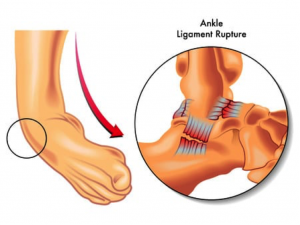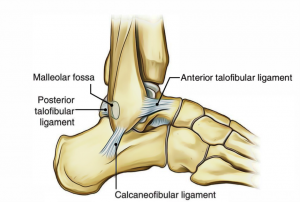Lateral ankle sprains
About:
Lateral ankle sprains are the most common type of ankle injury and highly prevalent in commonly played Australian sports, AFL, basketball and netball. Lateral ankle sprains comprise approximately 85% of all ankle sprains, this is due to the anatomical make-up of the ankle whereby the movement inwards is greater than outwards; this is due to the fibula extending further down than the tibia. They also have a high risk of re-injury, with basketballers reporting re-injury rates of approximately 70%, which increases with poor rehabilitation.
Symptoms:
· Pain over the lateral portion of the ankle – most commonly below the bony prominence known as your lateral malleolus
· Pain when walking, running and jumping
· Can present with loss of power in ankle movement secondary to pain
· Pain with ankle movements usually involving pointing toes and turning foot inwards
Differential Diagnosis:
Fractures involving the fibula and other bones in the foot such as the navicular, talus and calcaneum con sometimes present concurrently with lateral ankle sprains. Difficulty weight-bearing can sometimes be an indicator of ankle or foot fractures and in some cases imaging such as x-rays or for some bones CT/MRI scans are appropriate to rule out bony involvement.
High ankle sprains are another type of ankle sprain less commonly seen but can present similarly to lateral ankle sprains. They often present with pain over the outside of the ankle but also more towards the front and usually don’t involve an inward rolling of the ankle like a lateral ankle sprain. Whilst difficulty weight bearing can also be an indicator, ankle movement inwards is not often painful. This injury involves disruption to either or both the anterior tibiofibular ligament (AITFL) and the syndesmosis (a ligamentous structure responsible for securing your tibia and fibula (shin bones) together.
Causes:
Lateral ankle sprains typically occur whilst running or jumping when the foot first contacts the ground again. The ankle is forcefully pushed inwards whilst landing creating a disruption to the lateral ligaments. This mechanism of injury also commonly occurs whilst stepping on an opponents foot in sport.

image source: https://www.howardluksmd.com/
The severity of these injuries can differ greatly and is often dependent on the degree of tearing sustained by the lateral ligaments and how many of the lateral ligaments are involved.
Anatomy and Biomechanics:
The lateral ankle ligament complex involves three ligaments that provide the ankle with lateral stability and restrict inward movement of the ankle. The three ligaments include:
· Anterior talofibular ligament (ATFL)
· Calcaneofibular ligament (CFL)
· Posterior talofibular ligament (PTFL)
The most commonly injured ligament of the three is the ATFL due to its anatomical location. Generally more severe lateral ankle sprains involve disruption of the CFL and PTFL in conjunction with the ATFL.

Image source: https://www.earthslab.com
Injury to these ligaments are classified via a grading system similar to other ligaments within the body:
· Grade I: microscopic stretching and disruption of ligament fibres, not commonly seen on macroscopic images such as US or MRI. These injuries are often painful however rarely compromise the lateral stability of the ankle.
· Grade II: macroscopic stretching and potentially partial tearing of the ligament which can be seen on imaging. Whilst also painful, these injuries often have associated laxity and minor/moderate compromise of the lateral ankle stability.
· Grade III: complete disruption (rupture) of the ligament often leading to moderate/severe compromise to lateral ankle stability.
Stability compromise is not only dependent on the degree of injury to the ligament but also which ligaments are involved.
Treatment:
Lateral ankle sprains are most commonly managed conservatively and without surgical intervention. Certainly, for ligament sprains that are classified as grade I or II rarely end up surgically managed.
Initial management usually involves bracing/strapping the ankle to reduce the stretch applied to the lateral ligaments and limit inward movement of the ankle/foot. This allows the lateral ligaments to stiffen and heal appropriately without repetitively disrupting the acute healing phase. In some cases, this may be done by utilising a CAM boot.
Rehabilitation of lateral ankle injuries involves completing strengthening exercises to re-condition the surrounding muscles before returning to activity. A major component of rehabilitation is re-training balance and proprioception.
Proprioception is also known as joint position sense; essentially the process of the nerve endings in your ankle transmitting a signal to your brain to let it know where it is in space, then your brain sending a message to the muscles in your ankle to coordinate movement and maintain you upright. It is re-training balance and proprioception that is important to reduce the future incidence of lateral ankle injuries.
In the cases of extreme instability, most commonly occurring via multiple lateral ankle sprains, surgical intervention may be required to reconstruct and stabilise these ligaments in order to reduce the risk of osteoarthritis and future ankle injuries. After which, a period of rehabilitation, similar to described above, over a longer period of time is required.
In most cases following a lateral ankle sprain, athletes can return to normal activity without the use of strapping or bracing safely. In some cases it may be advised that long-term lateral support is needed in order to better reduce the risk of repeat injuries.
